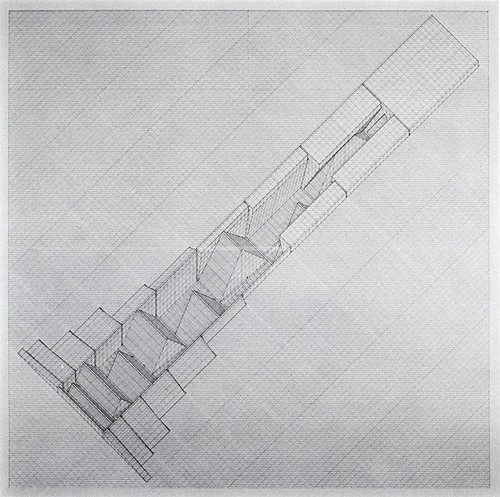''ONECITY,'' the chief project in the show, has, the artist says, ''very little to do with advanced planning theories of the present'' or with the ''utopias of the future, but rather with the dark cities of mythology, which exist outside of normal times in some strange location of extremity.''
An imaginary labyrinth 650 miles square, symbolized by a floor plan that paces off at about 30 feet, it is ''situated'' between the Mississippi and the Rockies and consists of many 2 1/2-mile-square structures, each divided into an ''Over-building'' and an ''Under-building'' and each containing nine arenas. Like the ''Star Trek'' scripts, the artist omits the logistical nuts and bolts, making paraphrase difficult.
It's clear, however, that the city's inhabitants are segregated into day people, wholesome types who study at home with their children by means of electronic devices, and night people. ''Tattered ghosts in phosphorescent clothing,'' the night people sound a lot like the more Felliniesque denizens of the Lower East Side, being given to masks and elaborate makeup; they ''mutter a lot'' and ''often carry around personal abstract structures'' that they exchange ''according to mysterious rituals.'' And while they have homes in the Over-building, they frequently sleep in the cubby holes of the Under-building, ignored by day people going about their business.
Alluding to New Yorkers' apparent obliviousness to bag ladies, Insley makes plain that while he himself may be without morals, his fantasy is replete with them as well as with ironic wit. Criminals, by the way, are sequestered in the ninth arena (Dante's?), where they are free to do what they will, including playing team sports like football.Here's an example taken from the BLDGBLOG:

Which goes on to say:
Courtesy of a comment left a while back on the sorely-missed site The Nonist, we learn that Insley once quipped: "what was absent from the ruin is often less marvelous than we imagine it to have been. The abstract power of suggestion (the fragment) is greater than the literal power of the initial fact. Myth elevates.’"And finishes:
ONECITY is a "masonite labyrinth," the article concludes, complete with "Wall Fragments" that have been "gridded with white or yellow lines and shaped like garment sections waiting to be sewn together." It's the city as dystopian clothing that we tailor to fit our future selves. Imagine a dusty third-floor walk-up in the Garment District of Manhattan, where precise plans for megastructures are produced on massive looms, needles and yawn moving to a hypnotic drone in semi-darkness. Architectural invention by way of sewing diagrams.More images, expandable, are available at the nonist (a moribund blog/site).
Intrigued by the gridlines particularly -- the rectilinear characteristic of the architectural/engineering drawing, of the blueprint, the draught. These are not maps, partly in that they have a different purpose, partly in that they refer always to the made, the consciously willed, as opposed to the so-called "natural". But, like maps, they are a representation of information. (Contrast maps/blueprints with knowledge of any kind, which is not a representation of anything.)
With the Game, looking to fuse various forms of visual information, including both map-type and blueprint-type. Interesting to think of being able to adopt different forms or instances of forms as one would put on clothes....
Think too of the idea of an imaginary architecture overlaid on a real city -- an imaginary complete with imaginary denizens, like "day people" and "night people". Overlaid, themselves, on the real people? "Unreal city", mythical city, ....
.
No comments:
Post a Comment